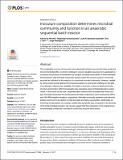| dc.contributor.author | Kumaraswamy, Rajkumari | |
| dc.contributor.author | Bastidas-Oyanedel, Juan R. | |
| dc.contributor.author | Rodriguez, Jorge | |
| dc.contributor.author | Perrotta, Allison | |
| dc.contributor.author | Alm, Eric J | |
| dc.date.accessioned | 2017-06-19T13:58:33Z | |
| dc.date.available | 2017-06-19T13:58:33Z | |
| dc.date.issued | 2017-02 | |
| dc.date.submitted | 2016-09 | |
| dc.identifier.issn | 1932-6203 | |
| dc.identifier.uri | http://hdl.handle.net/1721.1/110006 | |
| dc.description.abstract | The sustainable recovery of resources from wastewater streams can provide many social and environmental benefits. A common strategy to recover valuable resources from wastewater is to harness the products of fermentation by complex microbial communities. In these fermentation bioreactors high microbial community diversity within the inoculum source is commonly assumed as sufficient for the selection of a functional microbial community. However, variability of the product profile obtained from these bioreactors is a persistent challenge in this field. In an attempt to address this variability, the impact of inoculum on the microbial community structure and function within the bioreactor was evaluated using controlled laboratory experiments. In the course of this work, sequential batch reactors were inoculated with three complex microbial inocula and the chemical and microbial compositions were monitored by HPLC and 16S rRNA amplicon analysis, respectively. Microbial community dynamics and chemical profiles were found to be distinct to initial inoculate and highly reproducible. Additionally we found that the generation of a complex volatile fatty acid profile was not specific to the diversity of the initial microbial inoculum. Our results suggest that the composition of the original inoculum predictably contributes to bioreactor community structure and function. | en_US |
| dc.description.sponsorship | United States. National Institutes of Health (P30-ES002109) | en_US |
| dc.language.iso | en_US | |
| dc.publisher | Public Library of Science | en_US |
| dc.relation.isversionof | http://dx.doi.org/10.1371/journal.pone.0171369 | en_US |
| dc.rights | Creative Commons Attribution 4.0 International License | en_US |
| dc.rights.uri | http://creativecommons.org/licenses/by/4.0/ | en_US |
| dc.source | PLoS | en_US |
| dc.title | Inoculum composition determines microbial community and function in an anaerobic sequential batch reactor | en_US |
| dc.type | Article | en_US |
| dc.identifier.citation | Perrotta, Allison R.; Kumaraswamy, Rajkumari; Bastidas-Oyanedel, Juan R.; Alm, Eric J. and Rodríguez, Jorge. “Inoculum Composition Determines Microbial Community and Function in an Anaerobic Sequential Batch Reactor.” Edited by Zaid Abdo. PLOS ONE 12, no. 2 (February 2017): e0171369 © 2017 Perrotta et al | en_US |
| dc.contributor.department | Broad Institute of MIT and Harvard | en_US |
| dc.contributor.department | Massachusetts Institute of Technology. Department of Biological Engineering | en_US |
| dc.contributor.department | Massachusetts Institute of Technology. Department of Civil and Environmental Engineering | en_US |
| dc.contributor.mitauthor | Perrotta, Allison | |
| dc.contributor.mitauthor | Alm, Eric J | |
| dc.relation.journal | PLoS ONE | en_US |
| dc.eprint.version | Final published version | en_US |
| dc.type.uri | http://purl.org/eprint/type/JournalArticle | en_US |
| eprint.status | http://purl.org/eprint/status/PeerReviewed | en_US |
| dspace.orderedauthors | Perrotta, Allison R.; Kumaraswamy, Rajkumari; Bastidas-Oyanedel, Juan R.; Alm, Eric J.; Rodríguez, Jorge | en_US |
| dspace.embargo.terms | N | en_US |
| dc.identifier.orcid | https://orcid.org/0000-0003-4378-9542 | |
| dc.identifier.orcid | https://orcid.org/0000-0001-8294-9364 | |
| mit.license | PUBLISHER_CC | en_US |
